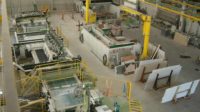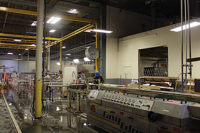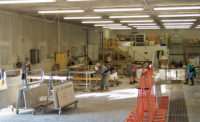Last fall, architects participating in the 15th edition of the Marmomacc Stone Academy’s continuing education program on stone design had the opportunity to visit Essegi Marmi’s quarry and stone processing plant. In total, there were 29 architects from the U.S., Canada, the U.K., India, South Africa and Malaysia who received scholarships for last year’s program. The architects spent five intensive days learning about design with natural stone — earning more than 20 AIA credits.
During the visit, the architects learned that while the beginning of Essegi Marmi dates back to 1963, the ownership’s family history in the stone industry can be traced to the 1600s. The translation for the Italian word Breccia is “fragmented rock.” Breccia Pernice is composed of fragments of red, pink and white limestone, and it is alternately referred to as a marble or a limestone.
The Breccia Pernice quarries developed along a large fault in the mountain known as the “tectonic zone.” A total of 70% of the quarry is active. Three distinct varieties of Breccia Pernice are produced. They are Classico, Medium and Light.
Classico is a sedimentary rock characterized by its reddish color. The material is taken from the center and upper parts of the quarry. Because of fragments in the stone block sizes can vary. Classico is primarily employed for interior applications.
The Medium variety of Breccia Pernice has less various-sized fragments and is pinker in color. It is extracted from the upper part of the quarry.
The Light material is located in the farthest part of the quarry. It is primarily pink in color.
For areas of higher extraction, a soft blasting technique is used to remove the stone. A combination of drilling and a diamond wire saw is used to extract stone in the lower portion of the quarry. Blocks are squared off with a diamond wire saw.
Essegi Marmi operates its quarries year round. Typically, there are four to five workers on site. Once a quarry is no longer used for extraction, some are re-filled with waste and used for agriculture, including vineyards.
At Essegi Marmi’s factory, blocks are cut with a BM gangsaw. Additional equipment includes a Donatoni Quadrix SPD CNC bridge saw, a Donatoni Quadrix DG 5-axis CNC machine, and a Lola 600 straight edge polishing machine.
According to Essegi Marmi, the importance of Breccia Pernice is its aesthetic value. It has been selected for projects around the world, including Trump Tower in New York City.










